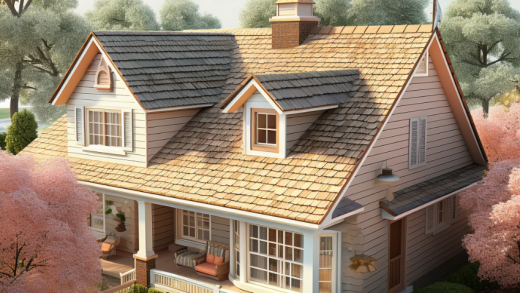World Champion of Roofs
Roofs are often the unsung heroes of architecture, providing shelter and protection from the elements while also adding beauty and character to a building’s design. But there are some roofs that go above and beyond mere functionality, achieving a level of innovation, sustainability, cultural significance, or sheer architectural wonder that earns them the title of World Champion Roofs. From ancient temples to modern skyscrapers, these roofing wonders showcase the best in global architecture and serve as inspiration for future roof designs. Let’s take a closer look at what makes a roof worthy of this prestigious title and explore some examples of the world’s most innovative roofs.
Understanding the Importance of Roofs in Architecture
Roofs play an essential role in architecture as they protect buildings from external factors such as weather, animals, and human-made objects. The importance of roofs is evident throughout history, where different cultural groups developed unique roofing styles to reflect their values and beliefs.
In addition to providing shelter, roofs create a defining feature for any building’s exterior appearance, giving it a visual identity that sets it apart from others. Roofing design can also enhance the functionality of a building by allowing natural light into spaces or providing insulation against extreme temperatures.
Different roofing materials such as metal, clay tiles, wood shingles, and asphalt have varying durability and environmental impact. Some eco-friendly options include green roofs which provide thermal insulation while offering an aesthetically pleasing view.
Roofing design continues to evolve with innovative technologies aimed at enhancing sustainability and reducing energy consumption in modern structures. From solar panels on rooftops to rainwater harvesting systems incorporated within roof designs, new techniques are being developed with more environmentally friendly approaches.
Understanding the importance of roofs in architecture highlights how these fundamental features contribute significantly towards creating functional yet striking buildings that meet our needs while respecting nature’s balance between form and function.
Defining the ‘World Champion of Roofs’
Defining the ‘World Champion of Roofs’ is not an easy task. It takes into account various factors that make a particular roof stand out from others. A champion roof should be more than just functional; it should also be visually appealing, innovative, and sustainable.
One of the key factors to consider when defining world champion roofs is their architectural significance. This means that they must contribute significantly to the overall design and appearance of a building or structure. The roof should complement other architectural elements and enhance the aesthetic appeal of the building as a whole.
Another important criterion for world champion roofs is innovation in design and materials used. They must push boundaries in terms of creativity, use alternative materials, or incorporate new technologies to achieve unique designs that are both stylish and functional.
Sustainability and eco-friendliness are also essential factors when considering what makes a roofing wonder worthy of being called a champion. The roofing material should reflect efforts towards environmental conservation through its production, installation, maintenance, durability, energy efficiency, among other aspects.
One cannot overlook cultural/historical importance while defining world championship roofs since they represent our collective heritage by symbolizing shared experiences over time with rich stories behind them.
In summary, it can be said that evaluating “world champions” requires looking beyond technical specifications alone but accounting for all these aspects holistically to appreciate how each contributes to making some roofs shine above others around the globe.
The Criteria for Champion Roofs
To determine the world champion roofs, there are several criteria that must be met. These criteria include architectural significance, innovative design and materials, sustainability and eco-friendliness, as well as cultural and historical importance.
Architectural Significance
Roofs are not just functional elements of buildings, but they also play a crucial role in the overall aesthetic and architectural significance of a structure. The design and style of roofs can make or break the visual appeal of a building.
Architectural significance refers to how well a roof complements and enhances the overall design concept of a building. A roof that is poorly designed or constructed can detract from an otherwise stunning building facade.
A well-designed roof adds value to any structure by harmoniously blending with its surroundings while creating an attractive silhouette against the sky. It should reflect local cultural motifs and architectural styles while embodying modern roofing technologies such as waterproofing, insulation, ventilation systems, etc.
The choice of materials used in constructing roofs has significant implications on architectural significance as different materials have varying textures, colors, patterns which will ultimately contribute to overall appearance. Modern architecture often favors flat roofs for their clean lines and minimalistic look whereas traditional designs tend towards sloping or pitched roofs.
In summary, having an aesthetically pleasing yet structurally sound roof is essential for any successful construction project. Its impact on enhancing the overall beauty of structures cannot be overstated making it critical for architects to incorporate innovative roofing solutions into their designs.
Innovative Design and Materials
Innovative design and materials are crucial in creating champion roofs. Architects must always push the boundaries of what is possible to create buildings that stand out from the rest.
One way architects achieve this is by using innovative materials, such as green roofs made with living vegetation or solar panels incorporated into roofing tiles. These materials not only provide unique aesthetic qualities but also enhance sustainability efforts.
Design innovation can come in many forms, from geometric shapes to asymmetrical structures. The use of unusual angles and shapes can create stunning visual effects while also increasing structural integrity.
Architects must balance form and function when designing innovative roofs. While a roof may look impressive, it must also be practical for its intended purpose, whether that be protecting inhabitants from the elements or providing natural light to interior spaces.
Innovative design and materials are essential components of world champion roofs. They allow architects to create functional, sustainable structures that push the boundaries of traditional architecture while still serving their intended purpose effectively.
Sustainability and Eco-Friendliness
In the world of architecture, sustainability and eco-friendliness are becoming increasingly important factors in design. A roof that is environmentally responsible not only benefits the planet but also provides long-term cost savings for homeowners.
One way to achieve sustainability in roofing design is through the use of recycled materials. Recycled content can be incorporated into classic roofing materials such as asphalt shingles or tiles. Metal roofs made from recycled steel or aluminum have become a popular option due to their durability and recyclability.
Another approach towards eco-friendly roofing designs involves green roofs or living roofs. These structures incorporate vegetation on top of a waterproof membrane which helps reduce heat absorption, improve air quality, absorb stormwater runoff and provide insulation while creating an aesthetically pleasing environment.
A sustainable roof should also be energy-efficient by incorporating features such as reflective coating to reflect sunlight and reduce cooling costs. Solar panels may also be installed on rooftops to generate renewable energy for homes.
It’s crucial that architects consider environmental impact when designing buildings including its rooftop designs. By choosing sustainable materials with lower embodied carbon footprints, we can help minimize pollution caused during production processes while reducing waste at end-of-life stages.
It’s essential that we prioritize sustainability and eco-friendliness in our choice of roofing designs so that our beautiful planet remains healthy for generations to come.
Cultural and Historical Importance
Architecture has always been a reflection of the culture and history of a particular region. This is especially true for roofs, which often represent the identity and traditions of local communities. In many cultures, roofing was seen as an art form rather than just a functional element.
Roofs have played an instrumental role in shaping historical events as well. In ancient times, roofs were used to provide shelter for religious ceremonies and other communal gatherings that helped shape societal beliefs and values.
Throughout history, different regions developed their own unique styles and techniques when it comes to roofing design. For example, Asian architecture often features curved roofs with intricate details such as dragon motifs or temple bells while Mediterranean architecture boasts flat-topped terracotta rooftops with brightly colored tiles.
In some cases, architectural designs were influenced by political power struggles throughout history. The French government’s ban on wood-framed buildings in Paris led to the development of innovative stone vaulting techniques that revolutionized European architecture during the Middle Ages.
Cultural and historical significance plays a crucial role in roof design across the world. It reflects not only our past but also shapes our present-day understanding of global architecture trends.
The World Champion of Roofs: Detailed Profiles
The world is full of stunning and awe-inspiring architectural marvels, and some of the most impressive structures are defined by their unique roofing designs. In this section, we’ll delve into the profiles of some of the world’s most celebrated roofs that have earned them recognition as champions.
First up is the iconic Sydney Opera House in Australia, with its distinctive sail-like roof design. The structure boasts more than 1 million glazed ceramic tiles on its exterior, making it look like a sparkling pearl in Sydney Harbour.
Next on our list is the Lotus Temple in Delhi, India. This temple features a beautiful white marble shell with 27 petal-shaped ribs arranged to form nine entrances that lead to a central prayer hall under an extraordinary dome.
Another masterpiece on our list is St. Basil’s Cathedral located in Moscow’s Red Square. Its colorful domes represent different chapels within the cathedral and feature intricate patterns using shapes such as stars, flowers, and crescents.
Moving over to Spain’s Sagrada Familia which has been under construction for over 100 years now; its numerous towers boast complex geometric shapes and incredible detailing symbolizing various biblical characters and events.
Finally yet importantly is Casa Batlló situated in Barcelona with an undulating blue-tiled facade resembling water ripples featuring balconies shaped like masks that seem to be looking down upon passers-by.
These detailed profiles represent only a fraction of what makes these roofs so special globally!
Roofing Techniques and Innovations Behind the World Champions
The roofing techniques and innovations behind the world champions are as diverse as their designs. Many of these roofs employ centuries-old traditional methods, while others push the boundaries of modern technology.
One example is the green roof on Chicago’s City Hall, which uses a layered system to support vegetation that helps regulate building temperature and reduce air pollution. Another is the Sydney Opera House, which features unique precast concrete shells designed to reflect light and create an iconic image.
Roofing materials have also seen innovation in recent years. The Beijing National Stadium’s “Bird’s Nest” roof was constructed using advanced computer modeling technology to ensure each steel beam was precisely placed to support its weight.
Other innovative roofing techniques include cable-stayed roofs like those found at Wembley Stadium in London, which use cables anchored into surrounding structures to suspend large sections of roofing material above seating areas without obstructing views.
Innovation continues today with new technologies such as 3D printing enabling architects and engineers greater flexibility when designing complex shapes for roofs. These advancements allow for even more breathtaking designs that could potentially become future world champions in global architecture.
The Impact of Climate and Culture on Roofing Design
Roofing design is not just about aesthetics and architectural innovation; it also takes into account the impact of climate and culture on the structure. The climate conditions in a particular region can greatly affect the roofing materials used, as well as its shape and slope.
In areas with heavy rainfall or snowfall, for example, roofs are designed to have steeper slopes to prevent water from pooling on top of them. In hot climates, flat roofs are often preferred to provide shade and ventilation while keeping the interior cool.
Furthermore, cultural influences play an important role in roofing design too. For instance, traditional Japanese architecture incorporates sloping roofs with broad eaves that extend beyond the walls – a feature that provides protection against heavy rainfalls. Similarly, Middle Eastern cultures use intricate patterns and designs on their domed rooftops as symbols of faith.
The impact of climate and culture on roofing design emphasizes how architecture is not solely concerned with aesthetics but also addresses practical concerns such as safety and comfort under varying environmental conditions. Architects who prioritize these factors create structures that not only look amazing but also stand strong through time.
Lessons from the World Champion Roofs for Contemporary Roofing
The world champion roofs have set the bar high for contemporary roofing designs. By studying their innovative techniques and materials, we can learn important lessons that can be applied to current and future projects.
One key lesson is the importance of sustainability and eco-friendliness. Many of these award-winning roofs were designed with a focus on reducing environmental impact, incorporating features such as green roofs or solar panels. As climate change continues to be an urgent issue, it’s essential that modern roofing designs prioritize eco-friendly solutions.
Another lesson from these impressive structures is the value of architectural significance. The world champion roofs are not only functional but also visually stunning, adding character and style to their surroundings. By prioritizing design alongside practicality, contemporary roofing projects can create buildings that stand out in unique and memorable ways.
In addition to aesthetics, cultural and historical importance should also be considered when designing new roofs. These award-winning structures often incorporate elements specific to their location or intended purpose, highlighting the rich history and traditions of local communities.
Many world champion roof designs demonstrate how innovation in technology can lead to breakthroughs in construction practices. New materials and techniques allow for greater flexibility in design while still ensuring durability and functionality.
By considering these lessons from past successes in global architecture, designers today can push the boundaries of what’s possible with innovative roof designs that meet both practical needs as well as aesthetic goals.
Conclusion
The world champion of roofs is not just about being aesthetically pleasing or functional. It encompasses a wide range of criteria that make it stand out from the rest. From architectural significance to innovative design and materials, sustainability and eco-friendliness, cultural and historical importance – all these factors make a roof truly exceptional.
The roofing techniques and innovations behind these champions are nothing short of remarkable. They showcase how human ingenuity can create wonders even in something as mundane as roofing design. The impact of climate and culture on roofing design cannot be overlooked either.
These world champion roofs have lessons for contemporary roofing too. As we continue to push boundaries with architecture and building materials, we need to keep in mind that functionality shouldn’t come at the cost of aesthetics or sustainability.
Roofs remain one of the most important aspects of any building’s architecture; they provide shelter, add character to buildings, and protect us from harsh weather conditions. And now thanks to our understanding about what constitutes a great roof- thanks to the World Champion Roofs- we can expect more beautiful designs that will add value beyond mere function!



